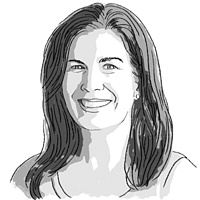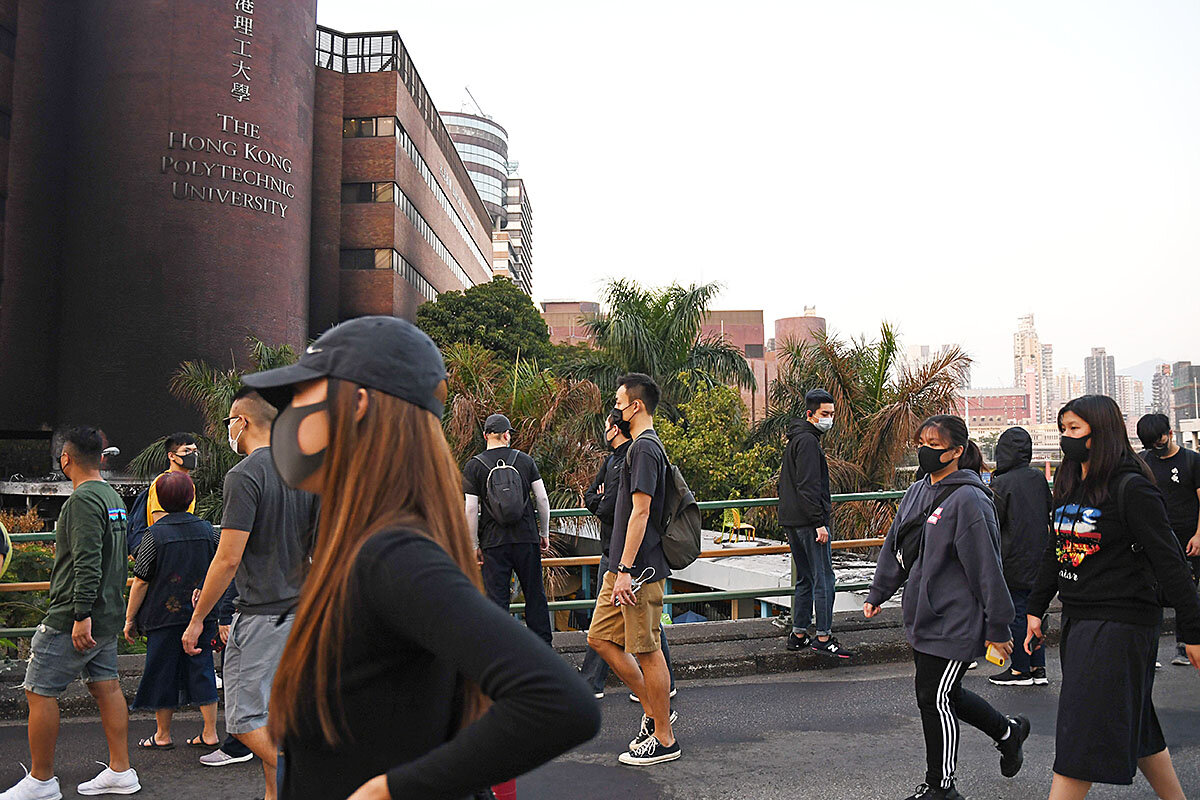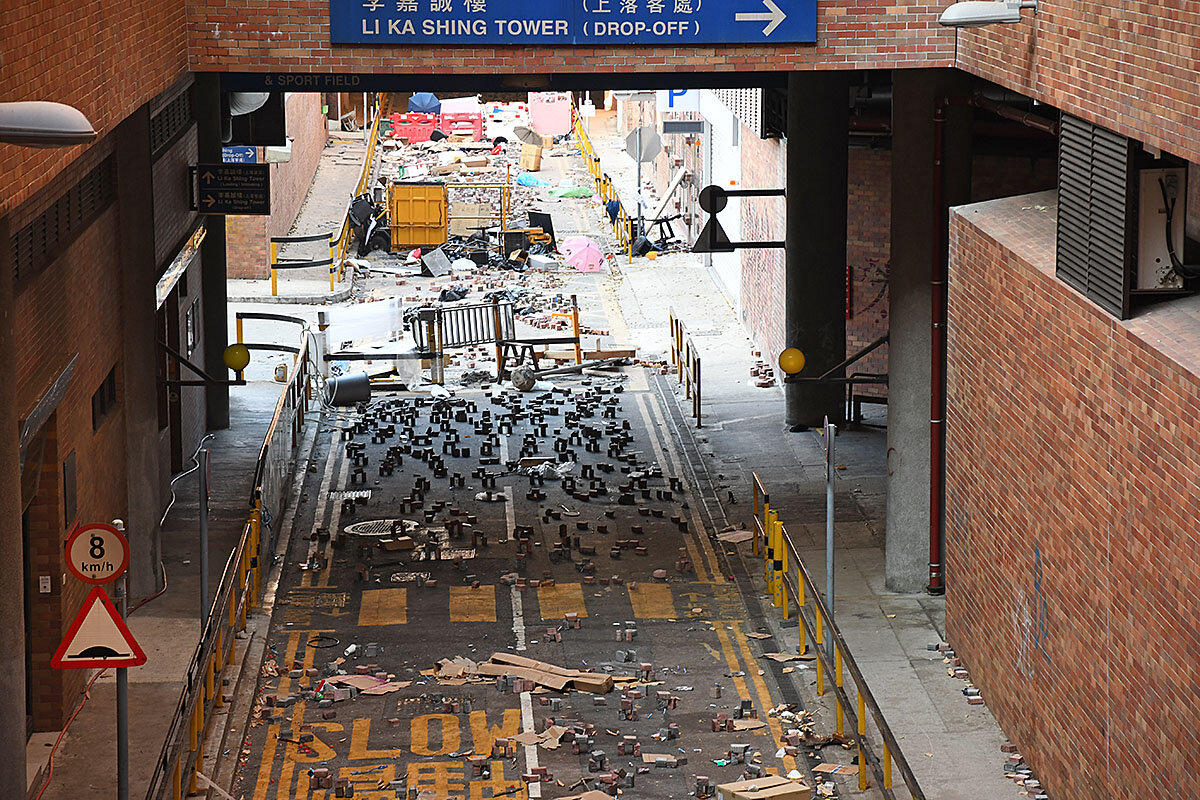After six months and a siege, Hong Kong’s front line takes stock
Loading...
| Hong Kong
With an impish smile and mop-top haircut, the college sophomore pulls up a chair at a backstreet cafe, his boyish looks and mild manners belying his identity as a frontline Hong Kong protester.
Before mass pro-democracy marches began in Hong Kong in June, the student was immersed in social science classes and campus clubs. Today, he is one of the yongmo – Cantonese for “brave militia” – the hardcore protest element that risks the most in head-on clashes with police, battling with Molotov cocktails, bricks, and umbrellas.
“It’s like a war,” he says, using the pseudonym Steve to protect his identity. Toughened by the conflict, Steve and hundreds of others have been wounded physically – and mentally – in their fight for greater democracy and autonomy from China. Consuming most of his time and energy, it’s become a sometimes surreal struggle that is defining him even as it transforms his home city.
Why We Wrote This
Time will tell if November was a turning point for Hong Kong. But the campus siege has likely left a deep imprint – nowhere more than in the minds and memories of the young protesters inside.
Six months into Hong Kong’s pro-democracy campaign, Steve and other activists offer an inside-the-resistance perspective, taking stock of its wins, losses, strengths, and weaknesses after the protests’ tensest chapter yet: a 12-day police siege of a university campus, with demonstrators barricaded inside. Overall, a tumultuous November saw two different challenges, they say: a spike in violence and a tactical setback that led to internal dissent, and a citywide election that some analysts believed could take the wind out of the protests. But so far, sizable numbers of Hong Kongers have continued to take to the streets. Convinced of their cause, Steve and others say the movement has resilience, broad public support, and unity – and won’t let up.
“We cannot lose, and we have nothing to lose” but everything to gain, says Steve. “We have fantasies about building a new Hong Kong … where everyone has a deeply rooted faith in their rights and democracy” and so will defend them against government encroachment, he says.
“Never seemed to stop”
Last month, the leaderless, nimble movement with the mantra “be water” made a costly, if inadvertent, misstep, Steve says. After calling for a general strike, protesters decided to block two main roads to give workers an excuse to stay home. They set up continuous roadblocks on the highway linking the New Territories bordering mainland China to the Kowloon Peninsula, and the cross-harbor tunnel connecting Kowloon and Hong Kong island – each located near a different university. But when protesters used the universities as staging bases, they lost their critical mobility, giving police an opportunity to encircle their fixed position and strike them hard.
Steve was one of hundreds of protesters waging an all-day battle against police from inside The Hong Kong Polytechnic University (PolyU) on Nov. 17. Protesters had a steady flow of supplies, both from inside the school and from thousands of ordinary people who brought them food, clothing, tools, and fuel for making Molotov cocktails.
The next day, Nov. 18, Steve says, he joined three attempts to break out of the police blockade – only to be pushed back each time. “They shot so much tear gas, it was so condensed you could basically see nothing,” he says.
Steve was already weak and in significant pain, having been shot twice in the leg with rubber bullets days before, as he took part in a roadblock to divert police from another campus, The Chinese University of Hong Kong – a strategy protesters call hoi faa, or “blooming flower.”
“The friend next to me only had a simple surgical mask,” he says. “He was unable to breathe” and barely made it onto the campus.
“The guy next to him didn’t make it and fell down the stairs,” and was caught by police, he adds.
In all police fired more than 1,000 cans of tear gas and rubber bullets in the battle that day, saying they “used minimum necessary force to disperse protestors.” Protesters hurled bricks and firebombs and shot arrows at the police.
“The gunshots never seemed to stop,” says another protester, part of a scout team, who gave her name as Ms. Z. “I was so panicked and afraid.”
Later that day, Steve found a secret route out through a side building and scrambled up a hillside to a highway. There he was picked up by a “parent car,” one of a fleet of private vehicles driven by supporters who circulate around hot spots and help protesters escape. “Police were already shooting tear gas at the car. I believe I’m one of the last few people to get out that way,” he says.
Police maintained the siege of the university for nearly two weeks, a low point in the movement for Steve. “PolyU was hell,” he says. “I’m the lucky one who got out,” he says, saying he’s haunted by survivor’s guilt over those who were arrested. “We lost many frontline protesters.”
More than 1,000 suspected protesters were detained at the university, raising the total arrested in connection with the demonstrations since June to more than 5,800. Police designated everyone inside the school as suspected rioters – meaning they could face charges that carry a 10-year jail term.
Two battlefronts
Protesters trapped inside – even those who escaped – say they were traumatized by the ordeal. Many felt they were defending their school against police. “Every night, I get nightmares about the experiences in PolyU,” says Ms. Z. “Although I escaped from there, I feel like I cannot get away from the siege. ... I will never forget how desperate it was.”
The police siege was unjustified and “has already resulted in very traumatic psychological problems,” says the Rev. Common Chan of Sen Lok Christian Church, who searched for protesters hiding on campus. His church is offering counseling to the protesters, who were left isolated, he says, after police detained dozens of medics.
Steve says the tactical defeat at PolyU caused some discord within the movement, but fueled even more anger at the police. “People were depressed due to the PolyU failure, but we still didn’t lose the battle, because the government is doing things that can’t be forgiven,” he says.
After the setback at PolyU, protesters strategically stood down, for the first weekend in months, to allow Hong Kong’s local elections to unfold peacefully on Nov. 24. The election produced a landslide victory for pro-democracy candidates, as the “silent majority” claimed by the pro-Beijing establishment weighed in instead on the side of the protesters. The activists received a major boost of international support on Nov. 27 when the United States enacted a law supporting democracy and human rights in Hong Kong.
Some analysts believed the local elections could redirect the movement toward institutions and away from street protests. But despite a huge win for the pro-democracy camp, Hong Kong’s Chief Executive Carrie Lam has not budged on the key remaining protester demands: an independent investigation of police conduct; amnesty for protesters, and dropping their designation as “rioters”; and universal suffrage to elect Hong Kong’s chief executive and all its legislators. Mrs. Lam did meet a major demand in October, by withdrawing the proposed China extradition bill that sparked Hong Kong’s protests last spring.
Instead, Steve says the protesters and the elected pro-democracy officials will push a shared agenda through different channels. “We have divided into two sections, the battle inside the institutions, and the battle outside the institutions,” Steve says. “Both sections support each other and are not in conflict.”
With large and small protests being staged in Hong Kong almost every day, Steve and the other “brave militia” are turning out in force. “I am actually not brave at all,” he says. “But … if I do nothing, who will? If we don’t sacrifice, then what about the people who died?” he asks. “This helps us keep going, toward the winning day.”









